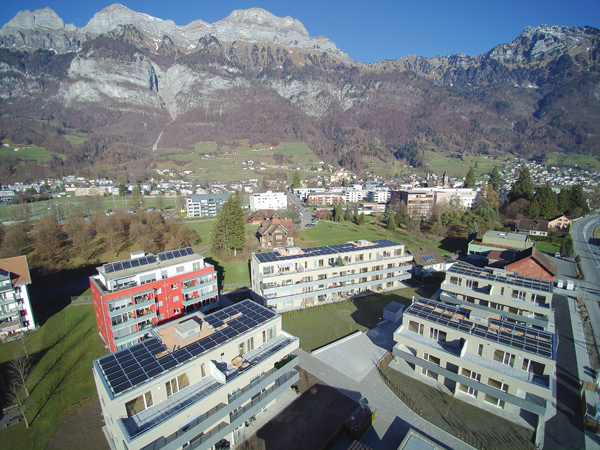Switzerland's first local electricity market successfully completed field testing in January 2020, the proponent Quartierstrom reported February 6.
 For one year, 37 households in Walenstadt traded locally produced solar power within their own neighborhood, using blockchain-based systems to keep track of transactions. Participants could directly buy and sell solar power within their neighborhood via a portal on which the participants could set their own purchase and sales price limits for solar power. The local electricity supplier, Water and Electricity Works Walenstadt (WEW), not only provided access to its distribution grid but also purchased surplus solar power and supplied the community with 'normal' power when the supply of solar power was insufficient.
For one year, 37 households in Walenstadt traded locally produced solar power within their own neighborhood, using blockchain-based systems to keep track of transactions. Participants could directly buy and sell solar power within their neighborhood via a portal on which the participants could set their own purchase and sales price limits for solar power. The local electricity supplier, Water and Electricity Works Walenstadt (WEW), not only provided access to its distribution grid but also purchased surplus solar power and supplied the community with 'normal' power when the supply of solar power was insufficient.
Supported by the Swiss Federal Office of Energy (SFOE) as a flagship project, the initiative aims not only to verify technical feasibility in the field but also to study user behavior. After a year in the field, project participants from research and industry gave an appraisal. Thanks to the local electricity market, purchases of the locally produced solar power almost doubled. The 37 households covered 33% of their electricity demand with solar power produced in the neighborhood – twice as much as beforehand.
One new feature of the system was that participants could use a portal to set a minimum sale price for their solar power and a maximum purchase price to buy solar power from their neighbors. "The participants frequently adjusted the price limits, especially at the beginning. But the price limit they set for buying local solar power was rarely higher than for normal power from the grid," said Verena Tiefenbeck, leader of the Bits to Energy Lab at ETH Zurich. On average, the participants were willing to pay just under 19 centimes per kilowatt hour – less than the cost of “mains power,” which stands at 20.75 centimes. Fewer than 10% of offers were above this rate, despite the fact that many people had declared their willingness to pay more for local solar electricity in the surveys conducted beforehand.
"This gap between attitude and action is seen in behavioral research time and time again," says Tiefenbeck. The researchers also attribute this to the fact that the participating households knew that local solar power was subject to lower grid fees and that, accordingly, the power suppliers were getting more for their power, even at lower prices. For their part, the households with solar power systems also sought to make a profit, asking for around 7 centimes per kilowatt hour. When selling to the power plant they made only 4 centimes.
The blockchain system proved highly robust, although its capacity was limited. Twenty-seven prosumers acted as validator nodes to approve the transactions in the blockchain. Those nodes represent the critical variable when it comes to scaling.
"The system could still handle about five more solar installations," says Arne Meeuw, who developed the blockchain system. The number of consumers could be increased further, on the other hand, and the system would remain stable with up to 600 pure consumers or other clients, such as batteries or flexible loads. "It would be possible to scale the system up by building multiple blockchains for different neighborhoods," he said. In turn, these could then exchange electricity between themselves.
Unlike public blockchains, such as those used for Bitcoin, the Quartierstrom blockchain is private. Moreover, the approval of transactions does not rely on elaborate computational processes. "The nodes reach an agreement on a proposed energy trade," says Meeuw. This mechanism doesn't require a great deal of computing power. The small computers that are used as smart meters and blockchain nodes consumed around 3,300 kilowatt hours of energy over the duration of the project. In terms of the volume of power traded in the local market, this consumption amounted to around 4%.
The pilot phase of the local electricity market as part of the SFOE flagship project has now come to an end. However, a follow-up project has been launched to ensure a seamless transition, albeit in modified form. The user portal has been redesigned and streamlined slightly, and prices are now set automatically. In the coming months, the hardware will gradually be replaced with series-produced equipment, and there are also plans to develop the trading platform into a marketable product. This aim is being pursued by the spin-off "Exnaton", which was founded by members of the development team at ETH Zurich. One option under development would allow participants to determine their preferred suppliers of local solar power, rather than setting prices. In other words, they could choose to buy electricity from their aunt's roof or from the farmer who sells them their eggs – a reminder that "Quartierstrom" has also demonstrated that emotion plays an even bigger role in a local market than price.
